高效饮水供应系统:提高产水率(RWR)项目
Introduction
.PNG)
Century of Experience in Urban Water Supply
1908~1944, The First Urban Water Supply System
Though Seoul was the first city in Korea to adopt a modern urban water supply system, the Korean War halted its continuous development. Therefore, it was not until after 1960s that the tap water technology truly took off in full swing. The foremost priority in water policies for Seoul was hygiene at the time. Water-borne diseases such as cholera, typhoid was rampant among those who used untreated, unhygienic water from wells and spring water, costing the lives of many citizens. The dire situation called for a water supply that is stable and hygiene. The first modern water purification plant was built in 1908, and water began to flow through the pipes of the system toSeoulites every day. The modern system, however, would inevitably displace many water peddlers whose livelihood relied on selling buckets of drinking water to each household. The then operating agency Korea Works Company hired the peddlers to minimize the damage of confusion in the transition to a modern water supply system.
1945~1960, Recovery of Purification Centers after Korean War
The 3-year Korean War that broke out in 1950 destroyed most of Seoul’s water supply facilities, including 30~90% of purification stations. Despite the odds, officials did their best to continue operating water supply even during the wartime. A special law was passed that allowed funding for waterworks recovery projects, and timely foreign assistance also played an important role. From 1954 for the following 5 years, thanks to the assistance of the central government and the UN, repair and maintenance projects could take place. Water facility expansion took off in earnest with Guui purification station plant 2 in 1956 which was constructed without relying on any foreign technical assistance. Since then, expansion and repair works continued, resulting in a 3-fold increase in water service per capita from 59ℓ in 1945 to 163ℓ in 1960.1961~1979, Water Facility Expansion
A rapid economic growth of the nation in the 1960s drove industrialization, urbanization, and a surge in Seoul’s population, which in turn inevitably caused an explosive demand for water in the city. To address water shortage, Seoul responded by expanding and upgrading already existing purification facilities as well as constructing additional ones from 1961 to 1979. Seoul also laid out a 10-year plan (1972~1981) to build and expand production facilities. All resources and efforts were geared toward meeting the explosive growth in water demand.
1980~1988, Stability in Water Supply
By 1980s more than 90% of residents were supplied with Seoul’s tap water, and the daily water supply per person reached 400ℓ. As was supply itself became quite stable, Seoul focused on building pressuring stations or booster pump stations to reach the population residing in higher altitude as well as upgrading old pipes to reduce leakages.The water quality control was facilitated by a computer system which made an automatic, remote control possible. Seoul then began channeling its resources and efforts to quality. Accordingly, Seoul established the Water Technology Institute and strengthened water quality standards to deliver high quality tap water to as many people as possible.
1989~Present, Seoul’s Tap Water Reborn as ‘Arisu’
Seoul’s tap water is now known as Arisu. Quality of Arisu is maintained through testings for 163 substances as recommended by WHO. All information, from water intake to supply, is disclosed to the public, ensuring public confidence in safety and cleanliness of the water that they are drinking. Having achieved stability in production, Seoul has pushed itself a step further to ensure good taste of the water. To this end, Seoul is working on adopting an advanced water purification system in all of its purification centers by 2015.Clean Water for Everyone in Seoul
Seoul’s purification capacity and service population jumped to an astonishing level: from 1908 to 2013, purification capacity jumped 348 times from 12,500 tons to 4.35 million tons, and its service population jumped by 83 times, from 125,000 to 10.39 million people per day. In fact, the total amount of water used in 2013 was 1,164,636,000 tons in cumulative terms or 3,191,000 tons on a daily average. The astonishing progress was made possible by continuous efforts in upgrading and building new water facilities, which helped resolve water shortage and ensure supply stability from 1998.Having achieved production stability, the Office of Waterworks at Seoul Metropolitan Government has shifted its focus on quality of water. To this end, Seoul has begun to adopt an environmental-friendly, advanced purification system using the ozone and GCA (Granular activated carbon). The system was first introduced to Yeongdeungpo Arisu Center in 2010 and is expected to be adopted in all purification centers in Seoul by 2015.
.PNG)
.PNG)
Water Supply Policy of Seoul
The challenges faced over the course of establishing a waterworks system for Seoul can be broken down into three sectors: 1) the aggressive expansion of the water network to serve growing population, 2) addressing demands for quality improvement, 3) efficient management and operation of waterworks. When the satisfying level of continuity and efficiency in water supply was achieved, the next policy agenda for water utility became achieving higher service quality and propelling management efficiency. There are mainly two stages in water supply. The most important and the basic step involves obtaining fresh water sources and preparing enough purified water, and the second is ensuring a stable distribution of the water to the end users. When it comes to the delivery, pressure boosting is an option for facilitating the process to highlands. As water is essential to human life, securing stable water supply in case of emergency cases or disasters should be considered.
The Early Stage of Seoul Water Supply
The first modern water supply system was introduced in December 9 1903 when C.H. Collbran and H.R. Bostwick was granted by Gojong of the Korean Empire the license to construct and operate water supply system. In August 1905, the license was transferred to Korean Water Works Co. which initiated the construction of slow filtration basin of Tukdo Water Treatment Plant in August 1906. The first official water supply system in Korea was completed two years later in 1908 and went into operation from September to deliver 12,500㎥ of water to 125,000 people daily. As for the organizational support, in order to address water issues in Seoul and boost the efficiency of its tap water management, 공익사업국 was established which would undertake water supply management. In eight local operation offices were installed for the management of water affairs in different administrative districts in Seoul. Notwithstanding all the hardworking, most of Seoul's waterworks became severely destroyed by the Korean War which broke out in 1950. After the war which lasted just over three years, 30~90% of the treatment facilities were ruined along with estimated 90% of the communications system. While facing such critical losses, the authorities and people in the water industry managed to administrate, tending to urgent needs. After the ceasefire in 1954 for the next five years, major rehabilitation and expansion projects began in 1954 with the help of UN aids and state funds. Due to the financial difficulties, the government had to resort to foreign aids and state loans to secure funds to restore the devastated water system. Korea received aid from the Foreign Operation Administration (FOA) in 1954 and the retitled International Cooperation Administration (ICA) in 1956 for the restoration and expansion of waterworks. Until 1961, a total of $1.742 billion in foreign credit was brought in from the ICA, DLF (Development Loan Fund) and their consolidated body, the AID/DG (Agency for International Development/ Development Grant). The series of post-war recovery projects was completed in 1955. With the completion of the No. 2 facility in Gueui Purification Plant in 1956 by a team of all-Korean staffs, a series of ambitious expansion and improvement projects was put on track. The continuous investments resulted in capacity increased three times, from 59 ℓ/person in 1945 to 163 in 1960.
Best Water Production Facilities
Around-the-clock Water Quality Monitoring
Since Seoul utilizes surface water of Han River as its source water, it is paramount that Seoul works closely with the municipalities near the river to most effectively protect its source water from contamination. To this end, Seoul is operating a Han River Watch Group who guards against illegal waste dumping and indiscriminate development in the area. Seoul’s effort is complemented the central government, manifested by the fund created by the Ministry of Environment. Created in 1999, the Han River source water management fund (KRW 3.9804 trillion as of 2011) is used to monitor and improve water quality as well as to support community activities.
Seoul is constantly monitoring and guarding its source water from contamination. For instance, Seoul conducts testings on 41 substances in 31 source water points and 142 substances in 6 intake points on a regular basis. In particular, the automatic water quality meter that can check the algae and phenol levels around the clock is in place. In addition, intake stations are equipped with a biological alert system that utilizes microorganism, algae, water flea and fish. Seoul is also investing in devices that help block oil leaks from penetrating into intake stations. Also, an algae alert system is in place which issues an alert when water temperature exceeds 20°C or when odor-causing materials (geosmin or 2-BIM) is detected in the purification facilities.
Guideline for Healthy and Tasty Water
To meet the growing demand for healthy and tasty tap water, Seoul has come forward with a new guideline that includes 3 categories regarding health and 6 categories regarding taste of tap water.
Quality Testing on 163 Substances
Today, Arisu undergoes tap water quality tests for 163 substances as recommended by WHO. Water in purification centers are under daily testing while water at faucets of 860 points also undergo stringent monthly testings. Besides, water at 120 water supply sites is tested on a quarterly basis. At purification centers, an automatic water quality monitoring system is in place to check the level of 6 substances. Such multilayered monitoring system keeps Arisu clean and safe.
Advanced Purification System
To deliver upgraded, premium quality tap water that satisfies cleanliness, safety, health and even taste, Seoul has adopted the Advanced Water Purification System which strengthens the current purification method by incorporating ozone and granular activated carbon (GAC, or charcoal). The two materials completely remove unpleasant taste and odor caused by algae, disinfection by-products and other micro-organic matters. With the introduction of the advanced system, Seoul can now deliver cleaner, safer water in which minerals are kept intact.
Membrane Filtering Purification System
The Ministry of Environment, Seoul Metropolitan Government and private companies joined forces to install an advanced version of filtering system, membrane filtering purification system or membrane integrity test.
Replacing the traditional sand filters, the new system removes contaminant particles in water more thoroughly, contributing to better quality and taste of water for end consumers. The cutting edge, eco-friendly method also eliminates the need for chemicals by 50% and simplifies management which, in turn, saves budget. Seoul’s membrane filters, which are made by 100% Korean technology, are the first of its kind to be introduced in Korea.
Chlorine Re-dispersion Facility
Although chlorine plays an essential role at reservoirs as disinfectant, it comes with unpleasant odor, driving many citizens away from drinking it. To tackle the odor, a small amount of chlorine is dispersed at multiple points, first at purification plants, then at the water supply reservoirs, instead of concentrating all chlorine at purification plants.
Expansion of the Treatment Facilities for Greater Capacity
Demand for water increased exponentially with the drivers such as fast urbanization and industrialization, making the necessity of expanding water facilities evident. In particular, extra administrative support was needed in vulnerable regions with lower water pressure such as highlands and extremities of the water supply lines. Under these circumstances, Seoul Metropolitan Government sought to mobilize financial resources through foreign aids and state subsidies. This effort allowed a full commitment in investing on water production facilities along with water supplying facilities and auxiliary water treatment plants. During the postwar restoration stage from 1945 to 1960, Seoul sought to establish a foundation for a self-sufficient waterworks technology with technical and financial assistance from foreign countries. Along with Water Act being established in 1961, facility investments in the water sector were promoted under the Five-year Economic Development Plan in 1962. The funding sources at this time started to diversify, from predominantly the United States to include Japan and Germany among others. The IBRD (International Bank for Reconstruction and Development), the IDA (International Development Association) and the ADB (Asian Development Bank) also supported the development of Seoul’s waterworks system in such forms as loans and free technical assistance.
Since 1952, overseas training programs for Korean tap water technicians have helped to advance the domestic tap water-related technology to the next level. Introduction of tap water project centers and education programs contributed to the training of working-level professionals. Under the first facility expansion plan (1960-1963), supplementary reservoirs in Sinchon, Miari, and Bulgwang-dong was newly built to serve fringe areas and expansion and repair works were done on Gueui, Ttukdo and Noryangjin Purification Plants. With the completion of the projects, the city’s water production capacity went from 277,600㎥/day to 348,600㎥/day by 1963. The second expansion project was conducted between 1964 and 1969. It included the construction of two purification plants in Bogwang, Siheung-dong, along with the improvement and expansion of the existing treatment facilities. As a result of the second expansion project, capacity was increased by 430,800㎥/day, making the daily production of Seoul waterworks system 826,600㎥/day by the late 1969.In fact, another ambitious project was slated for a short period of 1970-1971, which would double the capacity of Seoul’s waterworks system. However, due to the delay in introducing foreign funds, the full execution of the project was not possible, so it had to end up with some expansion works done on Tukdo, adding 453,400㎥/day in water production. In 1972, a 10-year plan for waterworks expansion was commenced to address the exploding demand for water as part of Comprehensive Municipal Administration Plan. The plan involved construction of large-scale purification plants (Yeongdeungpo, Bogwang and Seonyu) and several improvement and expansion works on existing facilities. By the 1980s as the result of such endeavors, Seoul’s waterworks system had a significant improvement with a total capacity of 3,070,000㎥/day. During this period, the waterworks project ran by a self-support system. Seven major cities of Korea (Seoul, Busan, Incheon, Daegu, Daejeon, Gwangju and Cheongju) embarked on waterworks facility improvement projects with state funds, which also financed the waterworks projects by local municipalities. In the late 1970s, the Multi-regional Water Supply Project was launched, consisting of six stages. It was the country’s largest project to develop a reliable water supply system for residential and industrial use. Once completed, the system was to deliver water to 24 local communities in the metropolitan area including Seoul, using the raw water from Paldang Dam. Due to the lack of local funds, the project was transferred to the Ministry of Construction. By the 1980s, owing to the steady expansions of production facilities and the slowing of population growth, water supply began to stabilize. The service rate went beyond 90%, and the daily water supply per person reached 400ℓ, a level comparable with advanced countries. However, this did not stop Seoul to pursue further expansion; its endeavor to keep up with its citizen’s rising demands for wider accessibility and improved reliability of the waterworks system continued. To finance further modernization project for water supply facility in the 1980s, the city introduced loans from the OECF(KO-22) in 1983 and the OECF(KO-30) in 1984. The loans provided funding for the basic plan and design for the project, as well as the acquisition of leakage restore equipment. Local bonds, together with the introduction of foreign loans, were critical in financing water supply.
Introducing foreign funds and local bonds for construction of water supply facilities not only mitigated the financial strains but also promoted technology transfer from foreign countries. This enabled Korean engineers to accumulate experience and expertise while working with foreign experts..png)
■ Tackling Quality Issues of Raw Water
Since the City was able to secure sufficient production capacity by the 1980s, increasing production capacity was no longer a priority. Besides, when water pollution became a serious issue worldwide, concerns for the quality of the source water began to rise. As the quality of Han River deteriorated from industrialization and urbanization, the management and protection of water sources became a priority. In the meantime, frequent water quality problems making the headlines led in public distrust in the quality of tap water, rendering the protection of water quality a national agenda. Subsequently
As citizens' interest in save drinking water sources grew, Seoul Metropolitan Government (SMG) came up with Water Facility Modernization Plan in 1985, coupled with a national comprehensive plan to raise water quality standards. Included in the plan was the introduction of automated quality monitoring system by introducing the computerized system to the treatment process. This was to establish an optimal management system of tap water quality through more effective pollution control.
■ Supplementation of Pressure Booster Stations and Distribution Reservoirs
To address the sustained water shortage in the underserved areas, 122 pressurizing stations in total were secured by 1989 and the privately held stations were nationalized. From 1985 to 1987, a total of 11 large distribution reservoirs were constructed, adding 648,000㎥ in capacity. With the acquisition of the new facilities, the capacity of Seoul’s water supply system more than doubled.
■ Improving Delivery System
Although the implementation of the continuous expansion projects throughout the 1980s brought a substantial improvement capacity in Seoul’s water supply system, further investment on waterworks was carried out to satisfy the citizens’ higher standards. Moreover, the city authorities wanted to ensure a reliable supply without outage against any eventualities, so it was necessary to secure spare production capacity.
Along with investments on new purification facilities, the existing facilities underwent renovation works. One example is a three-stage expansion project for Amsa in 1989, 1991 and 1998, with the aimed capacity increase of 250,000㎥/day, 320,000㎥/day and 300,000㎥/day respectively. Construction of Gangbuk Water Purification was also performed around this time over two phases: phase 1 was completed with a capacity of 500,000㎥/day in 1998 and phase 2 with 500,000㎥/day in 1999. After completing facility expansion works on Tukdo, Bogwang and Yeongdeungpo plants, the total production capacity of 7,300,000㎥/day was attained as of 1999, sufficient enough to provide a reliable supply.
In keeping with the newly added capacity in production facilities from the expansion projects in the 1990s, investments were made on the construction of a series of large-scale reservoirs. This indicated a shift in the mode of tap water supply from the direct distribution system to the indirect distribution system, which would ensure higher operational availability and reliability. The investments resulted in opening of 22 new distribution reservoirs, achieving a total storage capacity of 1,260,000㎥ and drainage dwelling hours of 4.4 hours.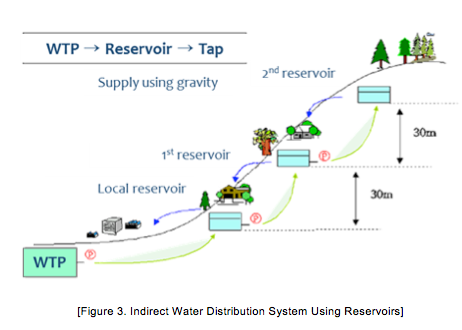
As an effort to improve the quality and reliability of tap water, a direct-coupled water supply system was promoted, which delivers water directly to each floor using the pressure of pipes, bypassing indoor water storages. This new system utilizes the pressure created by the different reservoir heights, saving costs for pressure boosting and can also improve water quality, eliminating dead storage problems.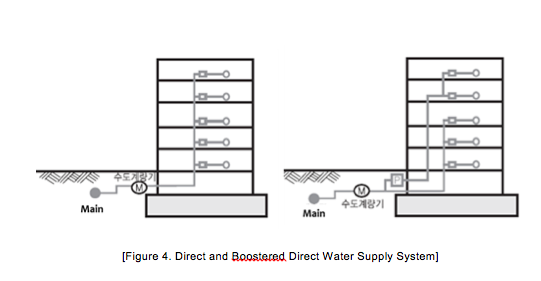
Safety and Stability of Tap Water
Large Reservoirs Ensuring Emergency Water Supply and Constant Water Supply Free of Outage
Reservoir is an important facility in urban water supply because it serves to ensure stability of water supply without outages as well as providing water in times of emergencies, such as power outage. Previously, a direct water supply system was used by which pressurizing stations or purification centers directly supply water to households. However, because the direct system comes with many disadvantages such as waste and instability in supply, Seoul saw the need to shift to an indirect system whereby water is supplied through water reservoirs. Understanding the importance of reservoir, Seoul built a large-scale reservoir through which water can flow naturally to service area. Since 1999, Seoul also turned some of the upper parts of the reservoir into recreational amenities for residents to use anytime they wish.
94.4% Revenue Water Rate (RWR)
Revenue water rate (RWR) refers to the percentage of supplied water that is not lost due to leakages or other factors. In other words, high RWR means higher revenue that is earned from the total water produced in the city. To raise RWR, Seoul introduced various measures, one of which deals with replacing old pipes that have traditionally caused water contamination; in fact, by 2013, 13,668km (95.4%) out of 13,034 km of old pipes past their life cycle were replaced with new ones. The remaining 634km of pipes are set to be replaced by 2015. Besides replacement, Seoul also built an additional 1,663km of pipe sized 400~2,800mm.
Seoul also successfully divided its complex water pipeline network into small 2,037 blocks and 100 middle-sized ones, making overall operation very easy and maintenance/repair more effective. With the subdivided system, only a very limited area would be affected during the time of leakage. In addition, emergency water supply and recovery became far easier. Diving the complicated network into smaller units even made it easy to detect which block was experiencing leak and the precise amount of leaks, pushing RWR even further. Seoul also applies a scientific and systematic detection mechanism. Examples include checking minimum flow level night when the use is minimal and a multi-point leak detection.
Seoul is also equipped with a science-based, real time water flow monitoring system. The system enables early detection of leak by checking water volume, pipe pressure on a real-time basis at 443 spots including pipes, pressuring stations, reservoirs.
Such measures helped Seoul to achieve a level of RWR on par with advanced nations in the field of tap water. Seoul recorded 94.4% of RWR in 2013, a 39.2% jump from 55.2% of 1989, which translates into a cost reduction of KRW 4.6 trillion.
Water Supply Geographic Information System
In the past, location and property information of water facilities were hand-marked on paper maps. This system caused some staff to unintentionally omit or enter wrong data, compromising accuracy which directly affects analysis, statistics while costing much time and energy overall. To address the issue, Seoul created the Water Supply Geographic Information System that utilizes GIS technology to create a digital database of design and properties information of water pipes, supporting components, and other urban facilities in general. It is an information system comprised of hardware, a software, and an application allowing input, output, and analysis of digital data. Today, GIS is applied to 13,841 km of water pipes, 260,000 valves, 1,991,00 water meters, and 301 reservoirs and pressuring stations. A survey method with satellite-based GPS and the latest tools using absolute coordinates based on the World Geodetic System.
Improvement of Revenued Water Rate
While supervising massive-scale facility investments, the authorities in Seoul’s waterworks faced a series of management challenges in the 1990s that threatened the quality of tap water and water service, such as waterworks pipe deterioration, billing and tariff collection difficulties and rising operation costs. Such problems demonstrated the necessity of an independent agency in charge of coordinating water-related affairs among different regional bodies, resulting in the launch of Seoul Waterworks Authority in 1989. Water supply in Seoul was significantly improved during the 1980~90s, with the acquisition of new major treatment plants and improvements made on old plants. By 1999, the city had achieved sufficient production capacity with a capacity of 7,300,000㎥/day. In the 2000s, with the continued facility expansion works and the investments to increase geographical coverage in challenging areas such as hillsides and extremities of the supply line, the service rate in Seoul reached 99%. Following the establishment of a reliable supply system, the policy agenda for waterworks went from supply-oriented schemes to "improvement of the waterworks management via control of water quality and increase of revenued water rate (RWR).“ RWR is an indicator to measure the percentage of billed water as a share of net water produced in filtration plants. Higher RWR means reduced tap water loss from leaks and metering failures, positively affecting financial viability of water utilities by increasing water sales and cutting unnecessary operating costs. Unaccounted-for-water (UFW), a term widely used by international organizations and scholars, means the difference between the quantity of water supplied via a city's network and the metered amount of water actually used by the customers. UFW consists of two components: (a) physical losses due to leakage from pipes, and (b) management losses owing to illegal connections and under registration of water meters. Lowering UFW is crucial in improving the financial health of water utilities and to protect scarce water resources. Though a bit different, both UFW and RWR are indicators of how well water utility is managed.
| Groundwork for RWR Improvement (1989 – 1995) |
Installation of flow meters by district offices (1990) |
| Replacement of old pipes (4,200 km) (1991 – 1995) | |
| Establishment of metering system based on district flow meters (1990 – 1995) | |
| Administrative Support For RWR Improvement (1996 – 1999) |
District level measurement of water production and RWR (1995 – 1997) |
| Introduction of small block system (2,037 blocks) for Minimum Night Flow(MNF) analysis (1998) | |
| Inauguration of Water Assessment Team (1998) | |
| Inauguration of an organization in charge of the RWR improvement project (1999) | |
| Installation of pipes with smaller diameter and standard flow meters (1996 – 2000) | |
| Establishment a district-level database on RWR (1998) | |
| Intensive facility management of redevelopment sites (1999) | |
| Attaining International Competitiveness (2000 - ) |
Shift to indirect water distribution system (2000 – 2003) |
| Systemic management of disused pipes (359 km) (2003) | |
| Launch of medium block system (2004) | |
| Introduction of multipoint interaction leak detectors (2004) | |
| Introduction of flow detection system for production quantity analysis and flow control (2005) |
While investing on capacity expansion programs in the 1980~90s, constant efforts were made to cut physical losses from the deterioration of the piped network. The programs by the authorities in Seoul waterworks to increase RWR are summarized in Table 1.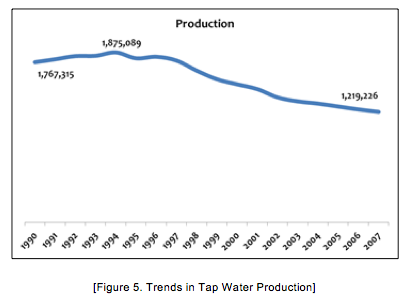
Such dedication against water losses brought about a significant improvement RWR of Seoul and this was followed by closure of aging treatment plants. After a modification process, Seoul’s waterworks is able to maintain a capacity of 5,400,000㎥/day, as of 2004. Following the downsizing of production since 2000, SMG transformed closed water treatment plants into recreational space for citizens such as Seonyudo Park. 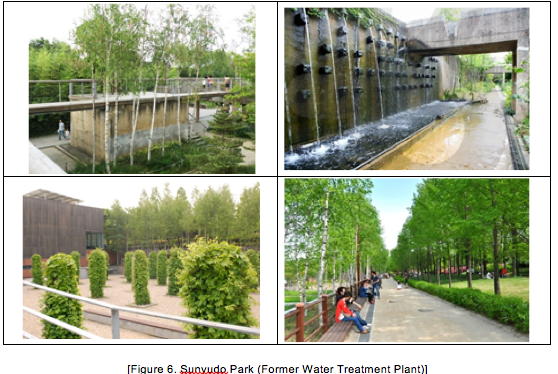
Increased RWR and reduced production demands facilitated the rationalization of management, which enabled the downsizing of staffs and operation costs. As a result, the water tariffs remained the same between 2001 and 2009. The reduction of water losses ultimately led to an improvement in water quality, as it involved facility upgrades and management rationalization.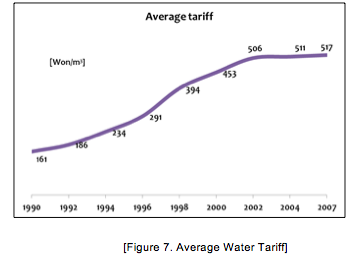
Efforts to Improve RWR
Controlling RWR and repairing pipelines had been two foremost policies at Office of Waterworks since the institution’s foundation in 1989. To prevent the deterioration and maintain a good condition of the pipe networks, it was necessary to replace or repair aged pipelines that can cause rust and leaks. For the maintenance process the existing pipelines were arranged into blocks, based on which replacement and repair works were carried out. The new arrangement allowed for systemic management of water flow rate and meticulous quality control.
Water loss is the amount of tap water lost before it reaches the end users. Water leakage can cause water quality deterioration and physical damages to the duct environment, which in turn leads to financial losses.
Causes of leakage are as diverse as deterioration of pipes, malfunctioning of valves, poor construction, overpressure, rupture, and numerous types of physical damage to pipes. As for leaking pipes, surrounding physical environments may be responsible, but they can also occur when disused pipes are left unremoved or disclosed.
■ Leakage Detection: Minimum Flow Analysis
As an effective measure to evaluate water loss in the supply network, Seoul’s water network adopts Minimum Night Flow(NMW) analysis. It is based on the average flow measured into a block within a time band (12:00 am to 4:00 am) when water consumption is minimum. When any observation over the minimum flow level is identified, the block is examined to make sure there are no leaks. This system enables conduct real-time assessment as well as delivering information to assist timely detection of irregularities. Each of Seoul’s tap water networks is divided into blocks to facilitate minimum flow analysis. In 1998, the minimum flow was defined at 1 ㎥/hr·km, then during the 2003 to 2005 period, it was set even lower, varying from 0.5 ㎥/hr·km to 1 ㎥/hr·km depending on the condition of each block. As from 2006 onwards, the blocks with estimated flow beyond the allowable amount(2.0 ㎥/hr·km) are tested exclusively.
■ Rehabilitation of Old and Disused Pipes
Deterioration of pipes can create critical water loss and public distrust in water service. An important factor to consider in planning for water main renewal, therefore, is pipe material. Pipes made of such material as grey cast iron, zinc, steel, and PVC installed before 1984 were prone to corrosion that causes frequent leakages and discolouration of tap water. Besides, pipes made of non-corrosive material that are older than 40 years needed be replaced due to the expiry of their life. The city’s replacement programs were promoted based on the priority outlined by Guildeline for Water Distribution Pipe Repairworks. Retrofftting water mains with frequent leak history were among the priorities, along with the pipes misaligned with the grid system, blocks with a concentration of aged pipes. Repairs on areas with a history of red water or overpressure were integrated with the scheduled maintenance work on nearby blocks, or a separate repair program was conducted focusing on the areas with numerous complaints of red water and small water flow. Among the old leak-prone pipes buried near streets, ones near main roads would be arranged first for a replacement. Some of the disused pipes kept connected to others in use were also subject to the pipe replacement program. Some of the existing pipes become abandoned when their connections to the mains are left unremoved after a replacement or repair work, causing severe water deterioration and leakage. Removal of these abandoned pipes brought a significant improvement of RWR.
■ Block-level Water Distribution System
To facilitate management of water supply, the entire water supply network of Seoul was divided into 2,037 small blocks. Based on this block system, the pipe network was rearranged so that tasks such as facility repairs, leakage detection could be managed more efficiently.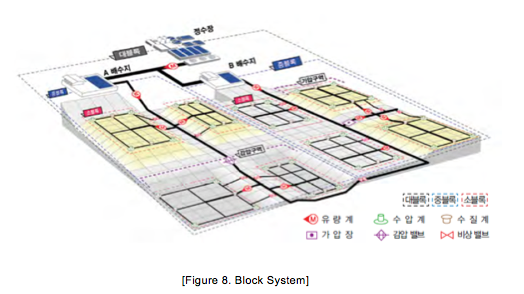
The minimum night flow analysis was first introduced in 1999 to the selected blocks. Using flow meters installed in at strategic points in these blocks, assessment of supply and usage is conducted at the block level. This methodology provides a useful set of data for identification of irregularities, helping to increase RWR. Conducting flow analysis can be more accurate and enables timely intervention if the water network is divided into small blocks but this can be also costly. For this reason, most blocks of Seoul’s water networks are of medium-size for management efficiency with the exception of low-RWR regions or frequent troubles, as Seoul’s water utilities has the RWR of 99%. In addition to employing the small-block design, reducing water loss in the target areas with lower RWR also involved relentless monitoring and repairs of leakage as well as intensive repairs of deteriorating pipes and maintenance of unused pipes. In the past, pressurized irrigation method was used to supply tap water to highlands, and this often caused surges and leakage and the rate of water lost through leakage can increase with excess pressure. Block-level management has proven to be successful in reducing and controlling overpressure problems.
■ Managing Risks in Redevelopment Sites
Redevelopment projects often involve demolition and infrastructure modification and take on average 10 years from appointment to completion and no investments in water facilities are allowed during this period, causing deterioration of the water pipes in the area. The existing water facilities buried underground are also very susceptible to damage that occurs during construction works. Such disruption of the water supply facilities violate city ordinances and causes water leakage, therefore the condition of valuable assets should be continuously monitored. Good practice in management can avoid possible water loss resulted from the deterioration of the existing water supply facilities buried in the redevelopment site. This means monitoring the following: 1) fraudulent activities such as unauthorized use of water, 2) leakage, 3) disclosure of distribution mains and joints, 4) open pipe ends, 5) redundant flow meters or power connections, and 6) ruptures or freezing of water meters. Seoul’s experience in preventing water loss at redevelopment sites has demonstrated that most water damage can be prevented with mitigation efforts and diligent management.
Scientific Operation of Water Supply
Cheapest Water Bills
Seoul strives to rationalize its business practices to push the water bill down, which can alleviate financial burden on the citizens. To this end, Seoul began outsourcing water metering operations, such as meter reading, to a private enterprise. Furthermore, the city government rearranged agencies working under SMG to streamline the administrative staff and work process while digitizing as much work process as possible, including billing and accounting. The efforts contributed to putting Seoul’s water bills one of the lowest in all cities around the world.
Arisu Integrated Information System
The Arisu Integrated Information Center monitors and analyzes all necessary information from water intake, purification, storage, distribution, and faucet quality management, contributing to producing and delivering stable and clean water to Seoulites. This system is capable of collecting and analyzing the operational information of the entire water supply system in real-time basis (6 purification stations and 8 branch offices), all of which used to be managed separately previously. With the center, Seoul is able to respond more effectively in cases of outage, shortage.
Seoul Water Now System
Seoul Water Now System is a real-time, automatic water quality assessment and online data disclosure service. The system analyzes water related data (pH, turbidity, residual chlorine, etc.) on 9 categories, and the data comes from automatic readers installed throughout 186 water facilities (6 water intake points, 6 purification stations, 84 reservoirs, 13 pressuring stations, and 77 faucets). The system issues alert or warning depending on how far the current situation exceeds or falls short of the permissible level. Most importantly, the system allows citizens to access up-to-date information on the quality of water via Seoul’s website at http://arisu.seoul.go.kr or phone call (Seoul Mobile Portal Service), etc.
Arisu Quality Verification Service
Many citizens trusted the safety of water produced in the purification centers, yet they were hesitant to drink tap water mainly because questionable conditions of pipes or water tanks. To eliminate this mistrust, Seoul adopted the Arisu Quality Verification System that provides free checkup services to citizen who request inspecting agents to visit their houses to verify water quality in their faucets. Households can get free water quality assessment on 5 indicators (turbidity, pH, iron, copper, residual chlorine) on the spot. The faucets that have passed the standard are given a certificate. In case the test results are not satisfactory, 7 additional items such as bacteria and colon bacterium are tested to identify the underlying cause. The information is then relayed to the operators to recommend water tank cleaning, old pipe replacement, etc.
Eco-friendly Energy and Renewable Energy
Committed to creating purification centers that pursue low carbon and green growth, Seoul set up a geothermal heating and cooling system in 3 purification centers (Yeongdeungpo, Gwangam, Amsa) and additionally set up PV facilities in Yeongdeungpo and Amsa purification centers. Seoul is currently working to develop a technology that can turn sludge to green energy in order to cut waste treatment cost while enhancing efficiency.
Waterworks Research Institute
Seeking to find the best ways to make tap water safe and tasty, Waterworks Research Institut conducts in-depth testing on WHO-recommended 163 substances and discloses the result online to the public on a regular basis. It is working in line with the government’s low carbon, green growth initiative by focusing on technology development. Another main responsibility of the institute is fostering experts, facilitated by its 16 different training programs.
The institute has achieved outstanding outcome, some of which include the membrane separation technology, eco-friendly ozone process, anti-rust pipe among many others. So far 8 patents have been awarded to the Waterworks Research Institute. This leading institute is at the forefront of sharing its accumulated knowhow and insights to help other businesses in water sector.
Bottled Tap Water
Seoul began producing bottled tap water in May 2001. The decision was made to promote Arisu to the wider general public by making it more accessible to people, and use as relief items in case of emergency. Currently, the production center for bottled Arisu is located in Yeongdeungpo facility that boast production capacity of 86,000 bottled Arisu daily. Since 2001, both demand and supply grew gradually for the bottled water; In fact, it was particularly useful for those affected by droughts in Korea and other natural disasters that hit many parts of the world. For instance, Seoul offered bottled Arisu to victims of the 2008 earthquake in Sichuan, China in 2008, the typhoon in Kaohsiung, Taiwan in 2009, and the earthquake in Japan in 2011. In addition, Seoul also sent bottled Arisu during Beijing Olympics. Seoul actively promoted its Arisu to the global community at the 2010 Shanghai Expo in its own pavilion. Clearly, Arisu is becoming a well-known tap water around the world.
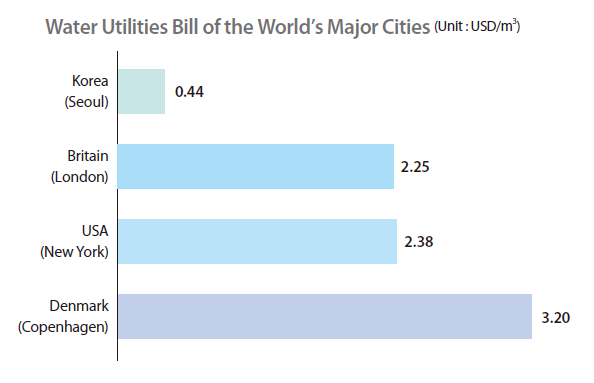
Improving Water Quality
Management of Water Sources
A key to the production of safe and clean water is securing good water source. Since Seoul’s tap water is reliant on Han River, it is subject to numerous sources of pollution from Seoul and the surrounding region. The main drivers of pollution were industrialization and population growth, and raised the necessity for adequate countermeasures to protect Han River from contaminants and pollution.
Aware of Han River’s degradation, Seoul Metropolitan Government came up with a scientific system to monitor the quality of the Han’s upper reaches, including 24-hour automated measure system at intake stations to detect the presence of microorganisms or phenolic compounds. In addition, to protect the source water from any accidental oil inflows, physical barriers such as fences and silt protectors are installed around intake stations.To promote citizens’s support and encourage their engagement in protecting source water, corresponding policy support accompanied. This included designation of special areas of conservation near the upper reaches of the Han River, such as 4 municipalities near Paldang Dam as a Paldang Watersource Conservation Zone in 1975. There are also special riverside zones in areas adjacent to dams and streams with regulations on discharging pollutants and other types of water source exploitations. To protect Jamsil’s water supply source, which provided a substantial portion of Seoul’s water supply, theh city banned pollution-inducing activities around the area in 1995. Also by July 1998, some of the aquatic facilities affecting water quality were relocated to the lower reach. There can be no doubt about the importance of governance in implementing such measures. The management of Han River’s water quality is a complex task as it involves a number of different municipal bodies and agencies. To integrate the efforts of different entities and stakeholders, Jamsil Water System Management Council was inaugurated in September 27, 1999, following the enactment of 'Law on the Improvement of Han River Water Quality and Support for Residents' in February 8, 1999. Chaired by The Minister of Environment, members of the council included Mayor of the Seoul Metropolitan Government, and governors of Gyeonggi-do, and the presidents of Korea Water Sources Corp. and Korea Electric Power Corporation. The council decides on the issues pertaining to the Jamsil region of Han River, such as collection and management of water fees, allocation of funds regulations on pollutants, and preparing pollution reduction schemes. To raise funding to compensate the inconvenience of residents in the water conservation zones, a tariff of 80 won per ㎥ was introduced, starting from 1999. As of 2009, Seoul Metropolitan Government charges 160 won per ㎥ of tap water and the collected rates go to Han River Water System Management Fund. By 2008, a total of 2,665.2 billion won had been raised including the total water rate collection of 1,222.8 billion. 640.1 billion won had been spent on community support projects, 513.6 won on the acquisition of lands in basin area, 705.9 billion won on the installation of environmental facilities, 640.1 won on operation and maintenance of environmental facilities and 357.6 billion won on other water quality improvement projects.
Monitoring Water Quality and Securing Supplementary Water Resources
When the quality of Han River became a serious issue in the 1980s, one of the first countermeasures to be brought up was to take water from the upper reaches of the river. The 48.3 billion won was invested to construct a new intake facility of 700,000㎥/day in Pungnap-dong. The construction began in August 1990 and completed in April 1992. The installation of a new intake facility resulted in a substantial improvement in the quality of Seoul’s water system. The quality of source water is a determinant factor of the purification process. Therefore, regular and integrated monitoring on source water not only can help to ensure the quality of source water but also is the most essential step for producing reliable tap water. According to Framework Act on Environmental Policy, Seoul Metropolitan Government has conducted regular monthly tests on 5 items at 20 water points of North Han River since July 1990. Currently, Seoul’s automated monitoring system performs regular tests on 42 items at 33 water source points, and 135 items at 6 intake points. The new pollution monitoring system was devised after the widely reported phenol spill incident in Gumi Industrial Complex in 1991. It led to the release of volatile pollutants into the drinking water of the area. Following the incident, water quality assessment and pollution management was identified as a major focus of Seoul’s water policies. A network of water quality monitoring stations was established throughout the city to detect pollutants and provide alerts when accidents arise. In 1992, an investment of 580 million won was spent to employ a new system network that can constantly monitor water quality, installing six automated monitoring stations in Amsa, Gwangam, Gueui plants. Two more stations of the same kind were installed in Jayang and Pungnap intake stations in 1993, allowing 24-hour automated water quality monitoring for all source waters that flow into Seoul. The data collected from the six stations are sent to the central system, which was integrated into Seoul Water Now System in 2005.
Managing Drinking Water Quality
Managing the quality of drinking water is an essential issue as it affects citizens’ health. Seoul’s waterworks system uses a process called risk assessment to set drinking water quality standards, which assumes that the average adult drinks 2 liters of water per day throughout a 70-year lifespan. Risks are estimated separately for cancer and non-cancer effects: strict standards are set at level that limits a person’s risk of getting cancer from each contaminant factor to 1 in 10,000 for cancer effects. Appropriate analytical techniques are indispensable for the detection of changes in water quality during distribution and for ensuring good drinking water quality at consumers’ tap. Seoul’s monitoring system is designed to encompass each step of the water supply chain from catchment to consumers. To monitor the effect of each treatment step, tests are conducted at various locations of water distribution networks based around 6 Arisu purification plants and 27 distribution reservoirs including 24 distributing points, 5 points at pressurizing stations and 26 taps at extremities of pipelines. Key-parameters are selected for the monitoring of water quality and the efficiency of the treatment steps and should be monitored in the water leaving the works and within distribution to check whether water is properly treated. The key parameters selected for Seoul’s waterworks are microbiology, pipe deterioration, and tertiary contamination. This criteria selection involves quarterly monitoring of 11 substances in total including residual chlorine, copper, zinc and iron, and hydrogen ion concentration, iron and copper. Based on the results of regular monitoring, at all locations of the water supply chain, Seoul’s tap water has satisfied all the criteria. The data on the selected biological and chemical water quality parameters selected provide essential information on changes in quality changes during distribution, performance of treatment technologies and catchment characteristics. Besides the regular monitoring, special monitoring may be necessary on some locations of the supply network that are particularly vulnerable to contamination. Since 2007, regions with anticipated degradation in water quality such as extremities of the supply line has undergone intensive monitoring at the medium block level. Also ongoing are additional quality tests on inlets starting from 2009, measuring six items at 298 points every month, and the test results are reported to citizens. These efforts are contributing greatly to citizens' confidence in Seoul’s tap water.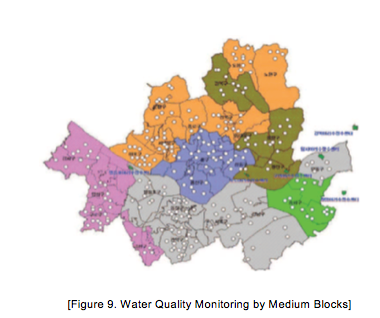
The impact of old pipes on water quality is also periodically monitored. Within the districts with a higher concentration of old pipes with a diameter over 400 mm, 12 sampling points (2 points per water system) are selected for the monthly testing; the test measures 12 items such as turbidity and bacteria. Secondary contamination from old pipes and the monitoring of water quality change in vulnerable regions are managed as priorities.
■ Seoul Water Now (SWN) System
To build an automated system for monitoring water quality from raw water to users, Seoul Metropolitan Government launched a comprehensive plan in 2001. Until the system’s completion in June 2005, 4.8 billion won was invested for the project. The cutting-edge system performs round-the clock monitoring of water quality during distribution. If the water quality does not meet the criteria, the monitoring system issues an alarm to prevent contamination. Measurement results are collected to provide the necessary indicator data needed to track performance over time. Engaging citizens in the surveillance of source water quality can contribute to a large extent to their trust in a high drinking water quality. "Seoul Water Now System" is designed to perform real-time monitoring of the water quality from the water source to its purifying process, open the water quality information online, and automatically detect any irregularity to take instant remedies. This system uses auto water quality testers installed at 200 spots in the course of producing and supplying tap water as well as a monitoring system for 5 items measured in 200 sites: pH, turbidity, chlorine residues, electricity conductivity, and water temperatures. 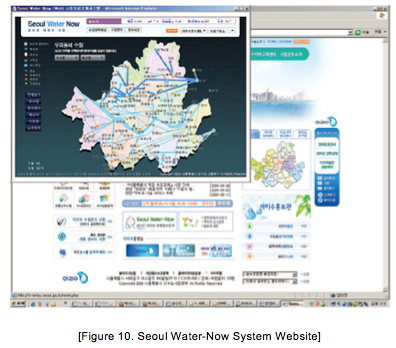
Arisu, Recognized Globally
Winner of the United Nations Public Service Awards, 2009
The United Nations Public Administration Network (UNPAN) awarded Seoul Water Now System and the Arisu Quality Verification System the highest recognition for its transparency and reliability of water supply service. In particular, Seoul was recognized for Seoul Water Now System, an electronic water quality service that allows citizens of Seoul to access up-to-date information on the quality of water supplied to their homes as well as the Water Quality Verification System, a free inspection service delivered to households upon their request.
Global Water Industry Innovation Award, 2010
International Water Association (IWA), the world’s largest water-related association composed of 85 countries, awarded Seoul the Project Innovation Award in June 2010, and again in October 2010 for Seoul’s premium Seoul tap water. It recognized Seoul’s highest RWR in the world, management improvement, and its focus on paradigm shift from safety to taste of water.
2010, International Business Awards
Seoul was chosen as the New product & Product Management and Product Development Department of the Year by Stevie Awards. Inc in recognition of creativity and management that led to the world’s highest RWR and business innovation.
2012 National Sanitation Foundation (NSF) Certification
Seoul’s Arisu acquired the NSF certification for satisfying water quality testing of all 167 substances. The passage demonstrates that Arisu is qualified as drinking water in the United States, proving the quality of Arisu worldwide.
Conclusion and Suggestions
Policy directions in addressing citizen’s demands for better water quality have to keep with the rising standard of living; it is rarely designed based on one perspective but rather grounded in citizens’ urgent needs. Securing a reliable water supply system has long been a primary focus of Seoul’s initiatives. More recently, developing advanced purification technologies has become a new issue not only because of its involvement in environmental and human health but because of the growing calls for improvement in tap water’s taste. Seoul’s highly advanced purification technologies help to remove the unpleasant tastes and odors as well as providing protections from environmental pollutants migrating in water. The strenuous measures taken by Seoul for the better water supply system, including facility expansion and RWR improvement projects, are not discrete projects but are all correlated with each other. The capacity building schemes to increase service rates led to improvements in RWR and water quality. The raised standard for drinking water with more factors added for the monitoring was also instrumental in achieving the internationally competitive level of water quality. As of 2009, the effectiveness of the system is well demonstrated by the improvement made in turbidity of 0.05 NTU, significantly improved compared with 0.43NTU in 1991. Without meeting quantitative demands first by increasing capacity of purification plants and distribution facilities, the advancements made in qualitative aspects of water service would have been impossible. The systemic management of both quality and quantity of water production allowed for efficient maintenance of water mains and deteriorated pipes, which in turn led to the increased RWR. Ultimately, the improvement made in RWR created a virtuous cycle as the enhanced efficiency in water distribution system led to greater quality and capacity of waterworks.
.PNG)
.PNG)
.PNG)
.PNG)
.PNG)
.PNG)